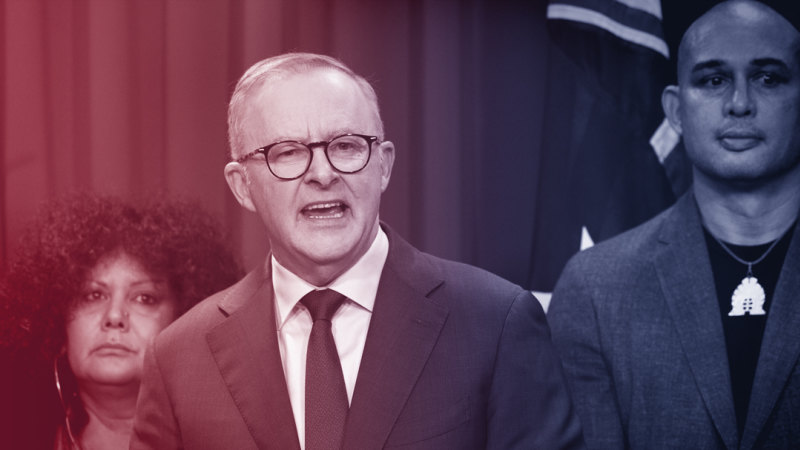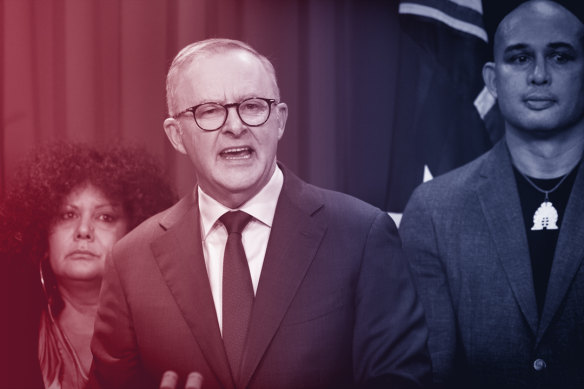Australians’ support for the Indigenous Voice to parliament is holding steady at 57 per cent but has slipped in Western Australia and Queensland to just 52 per cent, underscoring the difficult task facing Prime Minster Anthony Albanese to push through historic constitutional change.
An exclusive survey for this masthead showed 46 per cent of voters would vote in favour of the constitutional amendment Albanese proposed last July, 32 per cent would vote against, and 22 per cent were undecided.
Prime Minister Anthony Albanese acknowledged the risk of failure when he unveiled the final wording of the proposed change to the Constitution on Thursday.Credit:Alex Ellinghausen
Those figures have not shifted since last month’s Resolve Political Monitor, but support has fallen from a high of 56 per cent in August.
When voters are forced to choose either Yes or No without an option to be undecided, as they will be in the referendum, 57 per cent were in favour, a statistically insignificant 1 percentage point dip from February, but down from 63 per cent in August.
Most states have seen a fall in support for the Voice. In Queensland, 52 per cent were in favour in February-March, down from 56 per cent in December-January, although this was from a smaller sample of 470 people and within the margin of error of 4.5 per cent.
In Western Australia, support fell to 52 per cent in February-March, from 61 per cent in December-January. However, the sample size was 242 people and the margin of error is 6.3 per cent. Both state results should be taken as indicative only.
For the referendum to succeed, a majority of voters in a majority of states must vote Yes, and with support falling in the two resources states, it would take only one more state to weaken to imperil the referendum’s chances of success.
The prime minister acknowledged the risk of failure when he unveiled the final wording of the proposed change to the Constitution on Thursday morning.
“It is a risk having a referendum. They usually don’t succeed. If you were just about positioning on politics as usual, you might not do this. But the people here can’t wait,” Albanese said, flanked by members of the Voice working group.
The latest survey of 1600 eligible voters was conducted by research company Resolve Strategic from March 12 to March 16, before the finalised wording of the constitutional amendment and additional detail about the Voice’s design were released by the government. It has an overall margin of error of 2.5 per cent.
From next month, Resolve will adopt the precise wording released by the government on Thursday.
The final wording of the question that will be put to voters and of the proposed constitutional amendment has been tweaked to clarify the power of the parliament to make laws relating to the Voice, potentially limiting the scope of the new body to influence decision-making.
A new sentence before the proposed three Voice-related clauses has also been added and states: “In recognition of Aboriginal and Torres Strait Islander peoples as the First Peoples of Australia”.
Resolve Strategic director Jim Reed noted that in the past few days, the final wording of the referendum question and proposed constitutional amendment had been released, and the actual campaign had been properly launched.
“This will have largely worked in the Yes case’s favour, as it was designed to do,” he said.
“What is going in the No case’s favour is the amendment itself and the debate over the Voice’s power to advise executive government, the scope of issues it can consider and the process by which it does so.
“The referendum has to get a majority of votes in a majority of states, so they’ve got to win four states. Two are already in trouble. If another starts to go south, it won’t matter if they get 50 per cent of the national vote. In purely electoral terms, it matters where you are winning, not just if you are winning.”
The survey also asked whether the Voice should be able to offer advice to executive government and parliament, as is proposed, just to parliament, or to neither.
This has been the subject of debate among politicians, constitutional scholars and the government’s expert panel of Indigenous advisers, and the results underscore how divided voters are on the details of the Voice model.
Twenty-two per cent of those surveyed said the Voice should advise both the parliament and executive government, 16 per cent said it should advise only parliament and 14 per cent said either was acceptable.
But 27 per cent of voters said neither the Voice advising the parliament nor the executive was acceptable and 21 per cent were undecided. Convincing that 21 per cent will be crucial for the Yes and No campaigns.
Yes Campaign Alliance director Dean Parkin acknowledged that polling on the Voice was bouncing around but insisted that support would build now the final wording had been unveiled.
“For the last few months, the discussion about the referendum to recognise Indigenous people in the Constitution through a Voice has been focused on the legal experts and politicians,” he said in a statement.
“With the release of the proposed referendum question and constitutional provision this week, we now have clarity about what Australians will be asked to approve. Our focus now is to provide this clarity in communities across the nation because when voters understand how simple and practical this question is, they will get behind it.”
The No campaign was approached for comment.
The survey also highlighted the ongoing divide between Labor and Greens voters versus the Coalition on the issue.
Seventy-two per cent of Labor voters and 86 per cent of Greens voters said they would vote Yes if forced to choose, compared with just 33 per cent of Coalition voters.
Just eight of 44 referendums have been successful since Federation, with the last ones on the retirement age of judges and the filling of Senate vacancies in 1977.
Cut through the noise of federal politics with news, views and expert analysis from Jacqueline Maley. Subscribers can sign up to our weekly Inside Politics newsletter here.
Most Viewed in Politics
From our partners
Source: Read Full Article



